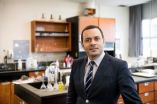(Press-News.org) When a piece of gift-wrapping tape sticks to itself, it's frustrating, but when small parts in a microgear or micromotor stick together, an electronic device may not work well, if at all. Scientists now report in the journal ACS Applied Materials & Interfaces that rough zinc oxide coatings can prevent tiny silicon parts from adhering to each other. The study could accelerate the development of even more advanced, high-performance electronics and small sensors.
Xinchun Lu and colleagues explain that adhesion is a big concern when designing very small silicon-based machines called microelectromechanical systems (MEMS). Today, MEMS are in many consumer products, such as cell phones, tablets, car airbags and inkjet printers. On this large scale, manufacturers can make sure that small parts have enough space and don't touch. However, when moving to smaller devices and parts for high-performance electronics, space is at a premium, and it's more likely that parts will touch. Silicon is widely used in MEMS devices, but it is sticky. The typical solution is to coat silicon with a water-repellent coating. Roughening up a surface can also help minimize contact between surfaces. Lu's group set out to see whether combining the two — using a water-repellent zinc oxide film with a rough surface — could work.
They investigated the stickiness of various zinc oxide films in the laboratory. They found that thicker films were rougher and had a lower adhesion force (were less sticky) than thin ones. Low humidity also helped, say the researchers.
INFORMATION:
The authors acknowledge funding from the National Science Fund for Distinguished Young Scholars, the Science Fund for Creative Research Groups and the National Science and Technology Major Project.
The American Chemical Society is a nonprofit organization chartered by the U.S. Congress. With more than 161,000 members, ACS is the world's largest scientific society and a global leader in providing access to chemistry-related research through its multiple databases, peer-reviewed journals and scientific conferences. Its main offices are in Washington, D.C., and Columbus, Ohio.
To automatically receive news releases from the American Chemical Society, contact newsroom@acs.org.
Follow us: Twitter Facebook
Rough surface could keep small electronic parts from sticking together
2014-03-05
ELSE PRESS RELEASES FROM THIS DATE:
Synthetic spider silk strong enough for a superhero
2014-03-05
Spider silk of fantastical, superhero strength is finally speeding toward commercial reality — at least a synthetic version of it is. The material, which is five times stronger than steel, could be used in products from bulletproof vests to medical implants, according to an article in Chemical & Engineering News (C&EN). C&EN is the weekly news magazine of the American Chemical Society.
Alex Scott, a senior editor at C&EN, notes that spider silk's impressive strength has been studied for years, and scientists have been trying to make a synthetic version of the super-strong ...
Lung transplantation: A treatment option in end-stage lung disease
2014-03-05
In the past five years, the number of lung transplantations carried out has increased by about 20%. In the end stage of various lung diseases, transplantation is the last remaining option for treatment, and it can both prolong life and improve its quality. Marc Hartert and colleagues have studied how patients do after a lung transplant, and their review appears in the current edition of the Deutsches Ärzteblatt International (Dtsch Arztebl Int 2014; 111(7): 107–16).
What they found is that deaths in the 90 days after an operation for lung transplantation have gone down ...
Experiential avoidance increases PTSD risk following child maltreatment
2014-03-05
Child abuse is a reliable predictor of post-traumatic stress disorder, but not all maltreated children suffer from it, according to Chad Shenk, assistant professor of human development and family studies, Penn State, who examined why some maltreated children develop PTSD and some do not.
Shenk and his research team found that adolescent girls who experienced maltreatment in the past year and were willing to talk about their painful experiences and their thoughts and emotions, were less likely to have PTSD symptoms one year later. Those who tried to avoid painful thoughts ...
Can low-dose interferon prevent relapse of hepatitis C virus infection?
2014-03-05
New Rochelle, NY, March 5, 2014—Chronic hepatitis C virus (HCV) infection can lead to serious diseases such as cirrhosis and cancer of the liver, so viral clearance and prevention of relapse are important treatment goals. Low-dose oral interferon may reduce the risk of HCV relapse in patients with mild liver fibrosis according to a study published in Journal of Interferon & Cytokine Research, a peer-reviewed publication from Mary Ann Liebert, Inc., publishers. The article is available free on the Journal of Interferon & Cytokine Research website.
In "A Double-Blind Randomized ...
ASTRO white paper provides guidance for optimal quality, safety of HDR brachytherapy
2014-03-05
Fairfax, Va., March 5, 2014— The American Society for Radiation Oncology (ASTRO) has issued a new white paper, "A review of safety, quality management, and practice guidelines for high-dose-rate brachytherapy," that recommends specific guidance to follow in the delivery of high-dose-rate (HDR) brachytherapy to improve quality and patient safety, according to the manuscript published in the March-April 2014 print issue of Practical Radiation Oncology (PRO), the official clinical practice journal of ASTRO. The executive summary and supplemental material are also available ...
New molecules doom proteins with kiss of death
2014-03-05
ITHACA, N.Y. – Like mobsters following strict orders, newly engineered molecules called "ubiquibodies" can mark specific proteins inside a cell for destruction – a molecular kiss of death that is paving the way for new drug therapies and powerful research tools.
Led by professor Matthew DeLisa, chemical engineers at Cornell University have developed a new type of antibody, called a "ubiquibody," which is an antibody fragment they have inserted into the natural process known as the ubiquitin-proteasome pathway (UPP). Their work appears in the March 16 issue of the Journal ...
Some metallic toys and low-cost jewelry present health risks for young children
2014-03-05
This news release is available in French.
We know that babies and young children often put non-food items in their mouths, a behaviour that occasionally leads to swallowing of foreign objects. Metallic toys and low-cost jewelry often contain toxic substances such as lead and cadmium. Do these objects present a health risk for young children?
To answer this question, Gérald J. Zagury, a professor in the Department of Civil, Geological and Mining Engineering at Polytechnique Montréal, and Mert Guney, a former doctoral student under Professor Zagury's supervision, ...
Half of pregnant women are passive smokers, due above all to their partners
2014-03-05
As shown in a study carried out by researchers at 13 research centres in Asturias, Gipuzkoa, Sabadell and Valencia, over half of non-smoking pregnant women, 55%, are passive smokers. These women are under the effect of tobacco smoke to a considerable extent because a member of the household, their partner in particular, smokes at home. The result of the study has been published in the journal Science of the Total Environment.
Within the INMA project that studies childhood and the environment, research has been carried out into the extent to which non-smoking pregnant ...
Sulphur haunts the ghost wreck
2014-03-05
Scientists from the same team have previously reported large amounts of sulphur and iron accumulation in the warship Vasa. In that study, the scientists found an outbreak of acidity and sulphate salts on the surface of the hull and other wooden objects.
'This is the result of biological and chemical processes that occur naturally in low-oxygen waters and in sediments,' says Yvonne Fors from the Department of Conservation at the University of Gothenburg and one of the scientists behind the article.
However, even if sulphur and iron accumulation is commonly occurring ...
Plumes in the sleeping avian brain
2014-03-05
This news release is available in German.
When we drift into deep slow-wave sleep (SWS), waves of neuronal activity wash across our neocortex. Birds also engage in SWS, but they lack this particular brain structure. Researchers from the Max Planck Institute for Ornithology in Seewiesen, Germany together with colleagues from the Netherlands and Australia have gained deeper insight into the sleeping avian brain. They found complex 3D plumes of brain activity propagating through the brain that clearly differed from the two-dimensional activity found in mammals. These ...




